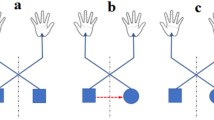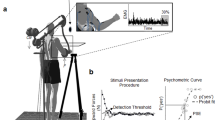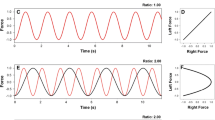Abstract.
In the present study, we investigated the influence of external force manipulations on movements in different directions, while keeping the amplitude invariant. Subjects (n=10) performed a series of cyclical anteroposterior, mediolateral, and oblique line-drawing movements (star drawing task) with their dominant limb in the horizontal plane. To dissociate kinematics from the underlying patterns of muscle activation, spring loading was applied to the forearm of the moving limb. Whereas spring loading of the arm resulted in considerable changes in the overall amount of muscle activation in the elbow and shoulder muscles, invariance was largely maintained at the kinematic level. Subjects produced the required movement directions and amplitudes of the star drawing largely successfully, irrespective of the force bias induced by the spring. These observations demonstrate motor equivalence and strengthen the notion that the spatial representation of drawing movements is encoded in the higher brain regions in a rather abstract form that is dissociated from the concrete muscle activation patterns underlying a particular movement direction. To achieve this goal, the central nervous system shifted between two or more muscle grouping strategies to overcome modulations in the interaction among posture-dependent (joint stiffness), dynamic (inertial), and elastic (spring) torque components in the joints. Spring loading induced general changes in the overall amount of EMG activity, which was largely muscle but not direction specific, presumably to represent the posture-dependent biasing force of the spring. Loading was mainly shown to increase muscle coactivation in the elbow joint. This indicates that the subjects tended to increase stiffness in the elbow to compensate for changes in the spring bias forces in order to minimize trajectory errors. Changes in muscle grouping of the shoulder antagonists were mainly a consequence of movement direction but were also affected partly by loading, presumably reflecting the influence of dynamic force components. Taken together, the results confirmed the hypothesis that changes of movement direction and direction of force in the end-effector generated specific sets of muscle grouping to overcome the dynamic requirements in the joints while keeping the kinematics largely unchanged. This suggests that directional tuning in muscle activity and changes in muscle grouping reflects the formation of appropriate internal models in the CNS that give rise to motor equivalence.
Similar content being viewed by others
Author information
Authors and Affiliations
Additional information
Electronic Publication
Rights and permissions
About this article
Cite this article
Levin, O., Wenderoth, N., Steyvers, M. et al. Directional invariance during loading-related modulations of muscle activity: evidence for motor equivalence. Exp Brain Res 148, 62–76 (2003). https://doi.org/10.1007/s00221-002-1277-4
Received:
Accepted:
Issue Date:
DOI: https://doi.org/10.1007/s00221-002-1277-4




